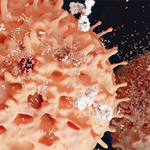Several other RA prevention trials underway have similar inclusion criteria. In the U.S., the three-year StopRA (Strategy for the Prevention of Onset of Clinically Apparent RA) study is randomizing individuals with ACPA positivity of two times or greater the upper limit of normal, but with no history of synovitis, to receive hydroxychloroquine or placebo for 12 months followed by 24 months of drug-free observation. The primary endpoint is the development of classifiable RA under the 2010 ACR/European League Against Rheumatism (ACR/EULAR) Classification Criteria.2,3 In the United Kingdom, the APIPPRA (Arthritis Prevention in the Pre-Clinical Phase of RA with Abatacept) trial includes individuals with positivity for both ACPA and RF, or ACPA at three times or more of normal, as well as joint symptoms that appear inflammatory, but without joint examination findings of synovitis at baseline.4 The intervention in APIPPRA is abatacept (or placebo) for one year, with an additional year of follow-up.
Several other trials are underway or in development to evaluate a variety of other agents, including statins and methotrexate, in similar autoantibody positivity populations without inflammatory arthritis or populations with signs and symptoms of early inflammatory arthritis but no classifiable RA.5,6
The rationale for performing these trials is based on several factors. The first is that ACPA positivity, especially at high levels, is highly predictive of developing RA. This is based on several retrospective case-control studies where ACPA positivity with or without RF positivity have demonstrated high rates (typically >90%) of progression to RA compared with antibody negative individuals.7-9 In addition, several prospective studies have shown that ~40–60% of ACPA-positive individuals develop inflammatory arthritis and/or classifiable RA over ~two to five years of follow-up—time frames that are feasible to study in clinical trials. Even higher rates of RA progression may be seen in certain individuals, such as those with even higher levels of ACPA, concomitant positivity for RF and greater degrees of joint symptoms. Other factors, such as ongoing smoking and obesity, and genetic factors, such as the shared epitope, also contribute to the progression of RA among patients with ACPA positivity.10-13
A growing number of other studies also demonstrate that early treatment of clinically apparent RA leads to improved outcomes and, perhaps, long-term drug-free remission.14 Because patients have evidence of altered immunity well before clinical presentation, this may imply that initiating therapy prior to the first clinical flare may have potential for long-term benefits, such as delay in first flare, a milder disease course or even prevention of disease altogether. Importantly, while the specific drug or duration of therapy ‘ideal’ to use in RA prevention is not clear, all the agents that have been or are being studied for RA prevention have been approved for use in clinically apparent RA and are generally well tolerated. Thus, they hold promise to be safe and effective in RA prevention. However, clinical trials will need to be completed to determine their real-life balance of efficacy, safety and tolerability when used in RA prevention.
New pharmacologic agents could be developed to target specific pathways that may be more relevant in preclinical RA, because we cannot assume that drugs that work well in the clinically apparent phase of disease are necessarily ideal for prevention.
What’s Next?
The field is awaiting the full results from these RA prevention trials. If successful, the paradigm of how RA is approached may be altered by adding prevention of the first clinically apparent flare of disease to a rheumatologist’s to-do lists. Of course, if prevention is shown in these studies to work in RA, a number of the issues discussed below will become critical to address, such as who to test and who to treat.


